(Audio clips from today in Africa will be posted as soon as it is technologically feasible.)
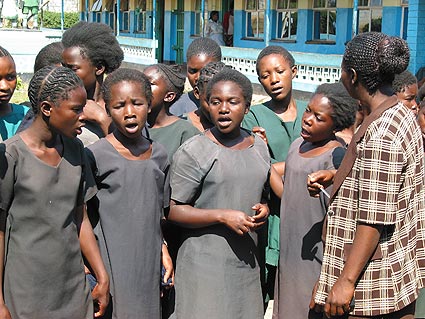
What an amazing day we have had. Just got off the phone with Cheri back in the U.S. As we recounted the miracles of the day she responded, “This is what is possible when life is living us.” We kept a mental log of the day as we went. It is recreated below:
6:25 a.m. After a brief six hours of sleep, we are in Brother Camillo’s office waiting for a phone call from the States. Brother Camillo has shown true Zambian hospitality (he is actually Italian but has been here for over 20 years) in generously offering his technology and office space to help us to be successful in our trip.
6:30 a.m. Cheri calls to tell us news of the CNN project. CNN is doing a story on Libby Roderick, a songwriter who wrote the lyrics to “How Could Anyone.” This is a song that we have been using at the end of There is Nothing Wrong With You retreats at the Monastery as it speaks directly to the experience of honoring the goodness in each of us.
CNN is recording the story of how the song has become famous around the world and is used by many groups who are doing work related to honoring oneself. They learned of our organization and were particularly interested in our work in Zambia. They would like a clip of us singing the song with the children of Masala Primary School here in Ndola to use on the program scheduled to air in August.
Cheri tells us that she is not sure if CNN will be able to send a crew to Zambia and can we please investigate to see if there is anyone around here that has high-quality video equipment who could film the clip for us. The clip needs to be done this week and it is Friday morning. So it is clear that we have only today to make this happen. It is a long shot, but since there is a printing press here on the property of the friary and we have heard rumor of an audio studio, we hold some faint hope that perhaps there is also some video equipment here that would be suitable.
7:15 a.m. We head to breakfast (armed with our soynut butter) and search for the friar in charge of the Mission Press.
7:20 a.m. In the dining hall, Brother Camillo points out Father Miha to us explaining that he is the man to talk to. He has just arrived home last night from a trip.
7:23 a.m. Within seconds of sitting down with Father Miha, we find out that right here in the heart of the friary is the most state-of-the-art video equipment in all of Zambia. He asks us to meet him in his office at 8:00 a.m. to make arrangements for the project.
7:25 a.m. With huge smiles, we sit down to eat a quick breakfast to give our bodies some fuel for what proves to be an amazing day.
8:00 a.m. We meet in Father Miha’s office. We tell him of Living Compassion and the many projects we have in Zambia. He is very interested and puts forth yet more contacts and ideas that could be most useful. We explain the filming project and tell him that it would need to happen today. He is unfazed and calls in his crew to set up the logistics. After arranging how it can all work, we gently approach the subject of how expensive it might be for us to make this happen. Father Miha tells us that there is only the cost of the video tapes, the Mission Press will donate the rest.
8:30 a.m. We leave the Mission Press with even broader grins and begin the work of trying to reach Ignatius by cell phone. We need him to walk to the school (the phones at the school are not working) and talk to Mrs. Mupeta to ask her if it is okay with her that we come to video at the school.
9:00 a.m. As we wade through technological and logistical challenges reaching Ignatius, we realize we need to go down to the tailor school and check in with Dorothy to finalize production for the meditation pants.
 9:10 a.m. We are in Dorothy’s office. Caverly is meticulously laying out sizing and exact placement for the labels of the pants. Jen is struggling with the cell phone that we have borrowed from Ignatius which rings every few minutes with no one on the other end.
9:10 a.m. We are in Dorothy’s office. Caverly is meticulously laying out sizing and exact placement for the labels of the pants. Jen is struggling with the cell phone that we have borrowed from Ignatius which rings every few minutes with no one on the other end.
9:15 a.m. Ignatius finally rings through successfully and is off to the school to talk to Mrs. Mupeta.
9:20 a.m. We send Alex to see if he can find a willing friar who could give us a ride to the school, assuming the whole project can move forward.
10:00 a.m. Negotiations with Dorothy are complete. We are successfully in full production of the pants! Ignatius has just called and is with Mrs. Mupeta. Jen talks to her about the video project. She is all for it, but says she must first get the permission of the District Education Office. Our hearts sink, knowing there is virtually no chance such a thing can happen within a few short hours. We ask her if it would be okay if we just come to the school now and teach the song to the children. Maybe we will film and maybe we will not. Mrs. Mupeta agrees.
10:15 a.m. We head to the school with Brother Joseph who Alex has found for us.
10:30 a.m. We stop at a local market on the way to pick up recharge cards for our cell phone. We bring Brother Joseph in with us to help us sort out which card we need, what the correct price is, etc. Nothing is straightforward for us—it is all new. We would be sunk were it not for the unfailing hospitality of all those who are hosting us.
 10:45 a.m. We arrive at the school. As we pass by each classroom on our way to the main office, the children recognize us from our visit the other day and greet us with such enthusiasm that we feel a bit like movie stars.
10:45 a.m. We arrive at the school. As we pass by each classroom on our way to the main office, the children recognize us from our visit the other day and greet us with such enthusiasm that we feel a bit like movie stars.
10:50 a.m. We sit down with Mrs. Mupeta and other senior teachers. They explain to us again the need to get permission and tell us that it would be best to plan to film late next week. We realize that waiting until next week will be too long and we will miss our chance to submit a clip to CNN. We continue the conversation for a few more minutes, exploring all of the various ways we can think to make it work. We come to an impasse and begin practicing our best letting-go skills. We gave it our all, but it seems it is not meant to be.
11:30 a.m. Mrs. Mupeta and several of the teachers are called away for a few minutes and our meeting is temporarily adjourned. As we sit in the office waiting, Ignatius leans over to us and asks, “How many children are you planning to film singing the song?” We respond that we had thought of teaching the whole school, but are open to anything. Ignatius explains that the reason he is asking is that we would only need permission from the District Office if we plan to film the whole school. Our grins return immediately realizing that this is the break we have been waiting for.
11:45 a.m. Mrs. Mupeta returns and we explain that it would be fine with us to just work with a smaller group of students. Before we know it, the entire thing has been set in motion: the choir teacher is off to gather her students, Alex goes to the entrance of the school (the only spot on the property where you can get cell phone range) to call in our video crew, we send Dave, Ignatius and one of the senior teachers to the local market to pick up some food and drinks for the choir members.
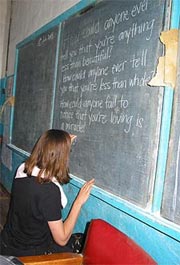 12:00 p.m. Jen and Caverly are escorted towards the room where the school choir has assembled. As they walk down the corridor they hear exquisite harmony coming from inside. We enter and are introduced to the students and we explain why we have come today. Jen writes the lyrics of the song on the board as Caverly begins to teach the tune. Steeped in a long tradition of oral learning, the children are quick to pick up the song. Respectful of following our direction, they sing the song in exactly the manner we have taught them and it ends up sounding quite flat in comparison to how they were singing just a few minutes earlier when we arrived. After some back-and-forth with the choir teacher, we are able to communicate to her that we would like them to add their own style and life to the song.
12:00 p.m. Jen and Caverly are escorted towards the room where the school choir has assembled. As they walk down the corridor they hear exquisite harmony coming from inside. We enter and are introduced to the students and we explain why we have come today. Jen writes the lyrics of the song on the board as Caverly begins to teach the tune. Steeped in a long tradition of oral learning, the children are quick to pick up the song. Respectful of following our direction, they sing the song in exactly the manner we have taught them and it ends up sounding quite flat in comparison to how they were singing just a few minutes earlier when we arrived. After some back-and-forth with the choir teacher, we are able to communicate to her that we would like them to add their own style and life to the song.
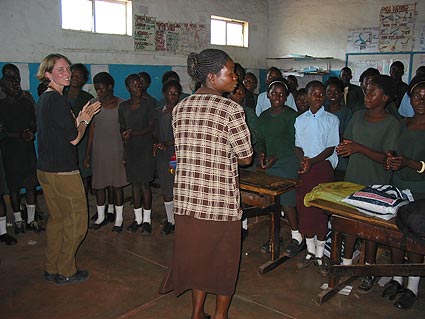

12:45 p.m. By the time Dave and Ignatius return, we are all swaying and clapping as we sing a Zambianized version of “How Could Anyone.” We take a break for each singer to have two rolls and a fruit juice. Dave explains to us that he combed the local market—an area consisting of dozens of tiny shops built with tree-limb poles and thatch walls—for a source of protein. The best he could do was the rolls and fruit juice and even that, Ignatius explained, would be for the children a tremendous privilege considering that on most days there would not be the resources for a midday meal. The lucky ones would satisfy their lingering hunger with a meager supper. Even Ignatius and Mrs. Mupeta explained that lunch is not usual for them as well. “You just keep yourself busy during the day and you forget about your hunger.”
1:15 p.m. Jacob, the cameraman arrives. We move the children out to the courtyard area where the lighting will be good. The camera rolls, the choir performs and the teachers, the other children and we watch and grin; a good time is truly had by all. After we have filmed “How Could Anyone,” the choir treats us to several other songs, including one which features the exquisite voice of a seventh grade soloist who is sure to be discovered if someone at CNN actually watches all the footage we send.
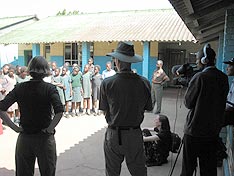 |
 |
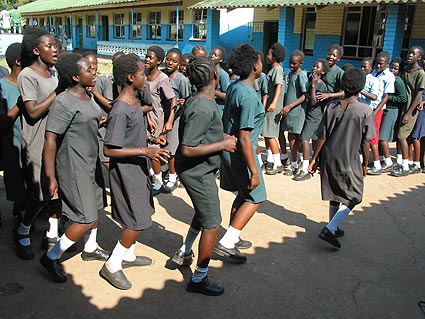

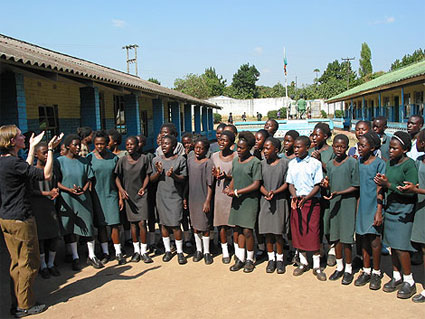
2:30 p.m. We wrap it up and head to Mrs. Mupeta’s office for another brief meeting.
In Mrs. Mupeta’s office, we lay the groundwork for the things we hope to accomplish when we return to the school next week. We agree that she and her colleagues will line up candidates to work on a large sewer project to divert city sewer blockage that ends up in the school yard. She is going to get permission from the district for us to do a video tour of the school to document the many needs. She will begin looking at what it will take to put a food program into the school so that every child gets at least one full meal each day.
3:00 p.m. Mrs. Mupeta and other senior teachers walk us out to the road to see us off. There is an air of excitement and possibility as we thank each other for a great day and look forward to meeting again next week to take the next steps in our projects.
3:10 p.m. We board a minibus—a Toyota minivan-like vehicle which seats about 12 passengers. It is the most common form of transport in Zambian cities. A ride costs 1,000 kwacha (about 20 cents). We ride only a short distance to a local market where we get out to find a taxi. We can safely take a taxi from here as Ignatius knows many of the taxi drivers in this area and can negotiate a fair price for us. Have we mentioned that we are blessed with saintly hosts?
3:35 p.m. We arrive back at the friary. Although we have only been at the friary for five days now, taking a left at the large brown-and-yellow-painted concrete wall into the friary property feels like arriving home.
3:45 p.m. We realize that we need to go down to check on the progress of the pants and be sure the new sizing we laid out this morning is working. We also need to check in with the video crew and start the process of getting a copy of the footage made so we can send it off to CNN.
We are all eager for a nap and thus decide to divide forces to finish our business more quickly—Alex and Dave head to the Mission Press, Jen and Caverly go to check in with the Dorothy at the tailor shop.
4:10 p.m. We meet back having successfully completed our tasks. Then, we call Cheri to report on our successes of the day. Full of gratitude for practice, we take a nap, eat dinner, work on our daily reports, and head off to bed.
10:00 p.m. The monks are all deeply asleep.
10:20 p.m. The newly arrived retreatants are belting out church music down the hall and wake us all up. Life never fails to be interesting.
Friday, July 22 10:10 PM
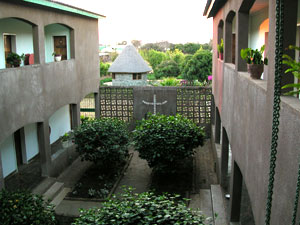 After Friday, or “The CNN Day” as the monks have been calling it, the trip took a turn in a new direction as the three other members of the Living Compassion team arrived in Lusaka.
After Friday, or “The CNN Day” as the monks have been calling it, the trip took a turn in a new direction as the three other members of the Living Compassion team arrived in Lusaka.
The same afternoon as all the excitement was happening in Ndola, Brother John came down to pick up Sande G. who had arrived from San Diego via Brazil. She enjoyed a long period of rest at the Assisi House, relaxing with the kittens and then happily greeted Sue and Sandy C. who arrived in Lusaka on Saturday after experiencing an amazing week in Zambia on safari.
 The first afternoon as they awaited the monks, the three retreatants gathered outside for an impromptu knitting circle, with the intention of making warm hats for the vulnerable children we would meet in Africa. Following dinner, the monks arrived with Ignatius and we all eagerly exchanged stories about CNN, travel, safari, and all our other adventures.
The first afternoon as they awaited the monks, the three retreatants gathered outside for an impromptu knitting circle, with the intention of making warm hats for the vulnerable children we would meet in Africa. Following dinner, the monks arrived with Ignatius and we all eagerly exchanged stories about CNN, travel, safari, and all our other adventures.
The next morning, we awoke early and had our first group sitting meditation in the beautiful thatched-roof chapel at Assisi House. Later, Brother John, Brother Charles and Ignatius came to take us to a church in a large, very poor compound (neighborhood) in Lusaka. Driving through the compound in one of the few vehicles we could see was quite an experience. Although the buildings were dilapidated, you could feel the presence and energy of life all around. Kids were waving, chasing after the minibus, smiling broadly and calling out “Mazunga!” which means “white people.”
We were whisked off to be entertained in an outdoor courtyard by one of the 28 choirs that take turns singing in the church. This group was all women wrapped in the same chitenge cloth printed with the emblem of the Catholic women’s league. We all enjoyed their dancing and singing accompanied by traditional African drums. Just when we thought that was as amazing as it could get, we were taken to hear another choir around the corner that had been waiting patiently for us. Our entire group expressed having a heart-opening experience listening to them sing harmonically in their native language. The sparkling eyes of one of the young male performers represented the overwhelming feeling of joy and welcome offered by the whole choir. We couldn’t believe they were using handmade musical instruments crafted out of seemingly random materials, such as bottle caps and nylon rope, but they somehow made amazing sound that left us with goosebumps.
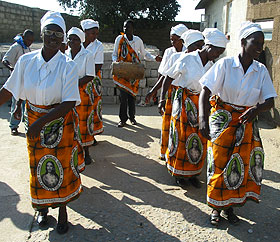

Play audio from dancers outside (or download
the MP3):
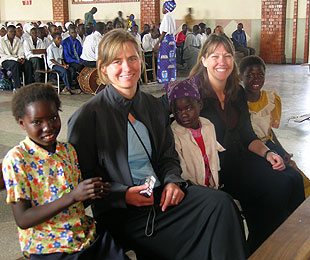 Children were very curious and drawn to us, particularly when we brought out our digital cameras where we could quickly show them their own images. Three little girls aged 6-7, Joyce, Prudence and Grace, attached themselves to Sandy and Sue and accompanied us into the church where we all sat together for the entire two-hour mass. As we enjoyed their giggles, smiles and hand holding, it was impossible to not also notice their tattered clothing.
Children were very curious and drawn to us, particularly when we brought out our digital cameras where we could quickly show them their own images. Three little girls aged 6-7, Joyce, Prudence and Grace, attached themselves to Sandy and Sue and accompanied us into the church where we all sat together for the entire two-hour mass. As we enjoyed their giggles, smiles and hand holding, it was impossible to not also notice their tattered clothing.

In the large church sanctuary packed with around 800 people, a traditional Catholic mass was presented with a distinct African flavor. Our group scattered ourselves around the congregation and Alex may have had the best seat of all, as he was stationed in the middle of choir taping. The music had everyone moving, including the priest and altar boys. Babies, tied on their mother’s backs with chitenge cloth, remained quiet and happy as everyone got in the spirit. The service was presented in Nyanja, the local language, and we didn’t understand a word until at the end we heard “The United States of America.” At that point, we all perked up and the priest welcomed us in English and we stood to greet the congregation.
Play audio from singing inside the church

As we left the service, many people crowded around to shake our hands and thank us for being there. Outside, our group experienced celebrity status as we were inundated with requests for photos. We all felt that we should be thanking them for giving us the gift of this joyful day. It was emotional leaving the children, particularly as they ran alongside the car for several blocks as we drove away.
We saw a very different part of town when we went to lunch. We were told that it was an upper-class neighborhood and one of only two shopping mall areas in Lusaka—the capital city of the country. To our eyes, it looked much like a middle-class strip mall, even with some American chain stores and fast food.
Following a period of holy leisure back at Assisi House, we were visited by a woman named Suki Sichinga, the editor of the Zambia Commerce Gazette, who the monks had met back in Ndola at Mission Press last year. We had a fascinating conversation about how successful projects are implemented and sustained in Zambia, as well as some potential pitfalls. It was helpful to gain a Zambian perspective, particularly from someone so close to the business community.
That evening, we had our first group discussion on our Africa retreat. Jen commented that as she had walked up to the chapel in the dark with the path all lit beautifully, the thought occurred to her that this was exactly the way she had visualized the retreat a year ago.
